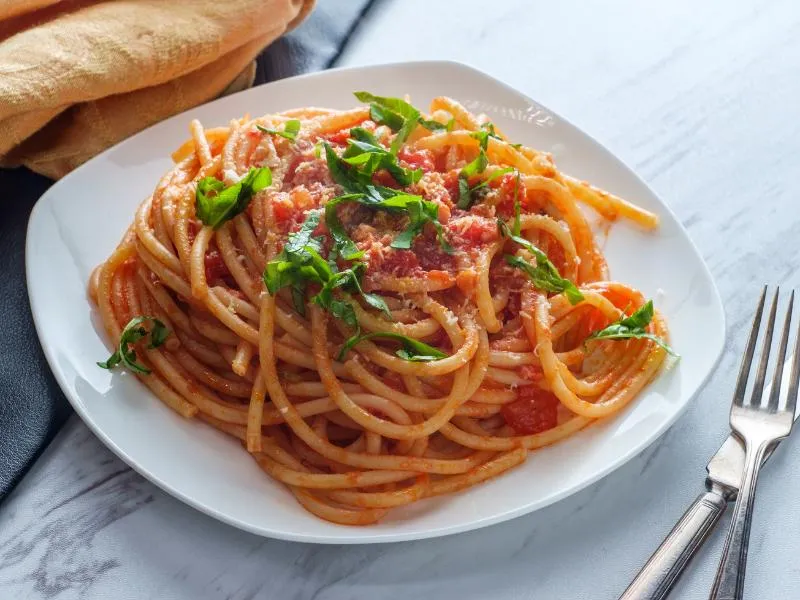Bucatini all’Amatriciana
Rich tomato sauce with guanciale and Pecorino Romano cheese tossed with hollow bucatini pasta.
👉 View Authentic Recipe 👈
About This Dish
Bucatini all’Amatriciana is a iconic Roman pasta dish that originated in the town of Amatrice, which was historically part of Abruzzo before becoming part of the Lazio region. Dating back to the 18th century, the dish was originally prepared by shepherds as “Gricia” (without tomatoes), evolving into its tomato-based version after tomatoes were introduced to Italian cuisine in the 19th century.
The authentic preparation relies on just a handful of high-quality ingredients: bucatini pasta (thick spaghetti with a hole running through the center), guanciale (cured pork jowl), San Marzano tomatoes, Pecorino Romano cheese, and a hint of peperoncino (dried chili pepper). The hollow structure of bucatini specifically helps capture the rich sauce both inside and outside the pasta.
Bucatini all’Amatriciana holds significant cultural importance and received official recognition from the Italian government with a “Denominazione Comunale” status. After the devastating 2016 earthquake that severely damaged Amatrice, the dish became a symbol of solidarity, with restaurants worldwide donating portions of sales from this dish to support rebuilding efforts.
🧑🍳 Analyzed by CucinaBot
Why This Dish Works
The culinary magic of Amatriciana comes from the perfect interplay of fat, acid, salt, and umami. The rendered fat from guanciale provides richness while imparting porky flavor compounds that bloom in hot fat. Tomatoes contribute acidity and natural glutamates that balance the fat and enhance savory notes. The hollow bucatini creates two distinct textural and flavor experiences: sauce clinging to the exterior while also filling the center, delivering perfect sauce distribution in every bite.
Key Success Factors
- Guanciale Rendering: Slowly render the fat from the guanciale until crisp but not burnt to create the flavor foundation
- Pasta Water Usage: Reserve and add starchy pasta water to emulsify the sauce and achieve proper consistency
- Minimal Ingredients: Maintain simplicity with just 5-6 ingredients to preserve the dish’s characteristic balance
- Al Dente Texture: Cook bucatini until firm (2-3 minutes less than package instructions) as it will continue cooking in the sauce
Common Pitfalls
Many non-authentic recipes introduce garlic, onions, or herbs like basil that overwhelm the dish’s essential flavors. Another common mistake is substituting pancetta or bacon for guanciale, which fundamentally changes the fat composition and flavor profile of the dish. The authentic version relies on the distinct sweet-fatty quality of guanciale and the sharp tanginess of Pecorino Romano, not Parmesan, which is milder and would throw off the intended flavor balance.
How to Judge Authenticity
When reviewing recipes, look for these markers of authenticity:
- Uses exclusively guanciale, not pancetta or bacon
- Contains Pecorino Romano cheese, never Parmigiano-Reggiano
- Includes minimal ingredients (no garlic, onions, or herbs beyond chili flakes)
- Specifies bucatini pasta, though rigatoni can be an acceptable regional alternative
- Finishes pasta by tossing directly in the sauce, not by topping plain pasta with sauce